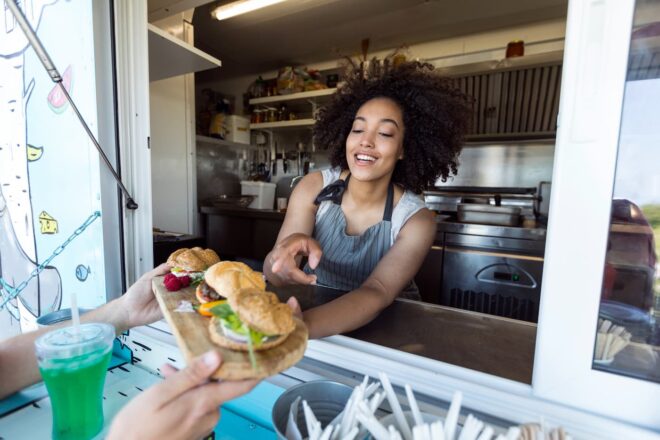5 tips for updating your tipping policy to retain employees
Editorial Team
8 min read
About 15.6 million restaurant employees in the United States are dependent on tips for their salary. Although the hospitality and food service industry is one of the largest employers in the country, the pandemic took its toll. According to federal data, restaurant and bar employees accounted for 25% of jobs lost (that’s 5.9 million jobs) at the height of the pandemic.
.
Now, more than ever, restaurants must stay competitive with the compensation packages they offer employees–especially when it comes to tipping.
A brief history of tipping in the U.S.
Tipping in the United States became codified in 1865 at the end of the Civil War, as employers began to hire Black workers as waiters and porters–without any pay other than customers’ tips.
Things changed to provide a measure of employee protection in 1938, when the Fair Labor Standards Act (FLSA) began requiring employers to pay a small base wage that, combined with tips, equaled minimum wage. Still today, the FLSA allows a restaurant to leverage a “tip credit”–the tip amount can be credited against the minimum hourly wage as long as the resulting total is equal to the state-mandated minimum wage.
This system–which effectively lowers the minimum hourly wage to as little as $2.13 per hour and decreases a restaurant’s financial responsibility for its workers–is still in use in Washington D.C. and 43 of the 50 U.S. states. Despite its troubling history, tipping is now so deeply entrenched in the restaurant industry, that it’s become a lifeline for many workers.
How tipping for takeout became a thing during the pandemic
To survive the otherwise crippling effect of pandemic shutdowns, many restaurants shifted to take-out-only establishments–at least for a time. That meant, in-house wait staff simply weren’t working or earning as much as before. In response, consumers began to show appreciation for their frontline service by tipping on takeout.
In fact, many people reported giving higher-than-usual tips when picking up or accepting deliveries. Case in point, this Eater poll in Detroit from October 2020 found that 70% of diners said they were tipping more than before the pandemic, an increase of 10% from a similar survey Eater conducted in spring 2020 when 60% of diners said they were tipping more.
Such was the origin of widespread takeout tipping. And it made people happy–restaurant staff were being recognized by patrons for their service, and consumers were able to express their support and appreciation for front-line service through take-out tips.
Fast forward to a post-pandemic marketplace, and tipping is once again changing.
Tipping practices post-pandemic
With rising prices and ongoing inflation, many consumers face shrinking budgets–and less cash in their wallets. That spells tipping fatigue for patrons and possibly less income for restaurant staff–especially those working takeout.
In fact, some suggest that Americans are worse tippers after the pandemic than before. While a 20% tip on a sit-down meal is still the gold standard of tipping, one survey revealed that the number of patrons tipping on in-house meals is on the decline–down from 77% in 2019 to 73% in 2022. Delivery hasn’t gone unscathed either. According to BentoBox, only nine in ten delivery orders received a tip. How can restaurateurs retain staff in an ultra-competitive labor market and ensure employees are well-compensated in spite of shrinking tips? By revisiting old compensation policies–especially tipping policies–to ensure they meet the needs of today’s workers.
5 ways restaurateurs can refresh tipping policies to retain employees
To strike a balance between changing market demands and keeping staff happy and well-compensated, it may be time to revisit policies affecting them–especially policies affecting employees who depend on tips for their livelihood.
Consider these 5 tips to help employees who depend on tips.
Tip 1: Raise the base rate and/or eliminate tips
Since Clover merchant Renee Trafton opened Beak Restaurant in Alaska, she has insisted on a gratuity-free experience. Instead, her menu prices reflect the outstanding service she knows her team delivers and allow her to provide a living wage. She found that in Alaska, where business slows down in the winter, it is important to guarantee a consistent paycheck to her employees. As a result, she’s been happy with the quality of workers she’s been able to attract.
This may require raising prices and using the additional revenue to boost employees’ base wages. (Our post How to raise prices successfully can help you implement this plan.)
To that point, Clover POS systems offer the ability to set up custom fees–like a living wage fee or a $1 fee, for instance, for online orders.
Tip 2: Get your employees’ input
Earning more than they would on some guaranteed-salary systems, many servers and bartenders still prefer the tipping system. Before making changes to your tipping policies, invite your employees to share experiences and suggestions that can inform any policy changes you may consider. Your employees can be a great source of ideas for how to weather the loss of tips, so be sure to include them in the policy-making process.
Tip 3: Change the way you distribute tips
As a result of new restaurant capacities and policies, employees may find their share of tips smaller.
If your state allows tip pooling, servers, bartenders, delivery people, and kitchen staff might prefer to share all or a portion of their tips. Doing so can help distribute tips more evenly across shifts and between roles within the establishment (think front/back of house and delivery staff, for example).
Understandably, waitstaff–who typically bear the brunt of guest demands–may be reluctant to share tips. So, in lieu of tips, some restaurants structure pay as a percentage of shift sales distributed across servers and kitchen staff. This approach also creates even more incentive for the entire team to sell more.
The key, as always, is constant and respectful communication with your team before making any changes.
Tip 4: Keep as much of the profit and tips in-house as possible
Third-party delivery apps take a significant cut of revenue and encourage guests to tip their drivers–not your staff. Clover Online Ordering, on the other hand, doesn’t add any extra charges to the merchant or the customer. What’s more, it offers contactless payment, helping protect the health and wellbeing of all parties–especially during flu and cold season. As a bonus, it can also reduce phone orders, taking some of the pressure off already busy front-of-house staff.
Clover systems offer four default tip percentages of the total sale for your guests to choose from, should you choose to add the ability for guests to tip on the final sale. Having a pre-set tip amount makes it easy for guests to tack on a gratuity for your staff–guests who might otherwise skip a tip.
Tip 5: Make takeout tipping the new norm with credit card tipping
Wages are up and jobs are plentiful, according to the Bureau of Labor Statistics. This tight labor market demands restaurateurs be creative as they strive to retain employees. Tipping strategies can play a significant role in a retention plan. Unfortunately, the old tip jar goes only so far when it comes to takeout tipping–and it’s becoming a rarity.
In fact, cashless transactions are ticking up steadily. According to a recent Gallup poll, only 13% of participants said they use cash for most purchases–that’s down from 28% five years ago.
Credit card usage has definitely increased, too: the number of credit card accounts in the U.S., on the other hand, increased to 555.36 million in the third quarter of 2022 (up from 549.87 million in the previous quarter).
For restaurants, particularly counter-service spots, credit cards present a great opportunity to encourage tipping. It may be time to retire the tip jar and enable credit card tipping on your restaurant POS system. It’s not only easy–it’s essential to retaining employees.
The Clover POS system gives you and your guests 2 simple ways to tip:
- Tip on Tablet / Tip on Screen–that also offers the benefit of flat tipping amounts based on the ticket dollar threshold
- Tip on Paper (think, writing a tip on a receipt)
Setup is really simple. You can configure tips on the Android app under Setup and Tips. Or, you can configure them on your Web Dashboard, under Business Operations and Tips. Even better, it’s customizable–you can set up your own tip suggestions for your guests–and add custom labels. Clover’s smart tipping feature also offers suggested tips as either a flat dollar amount (great for coffee shops, for instance, with low-ticket totals under $10) or as a percentage of the sale (better for larger ticket totals over $10). It even lets merchants use flat tipping instead of a tip percentage for sale amounts below a total sale threshold that you define. And, Clover is always here to help with answers to your questions.
Retaining your staff means ensuring they can earn sustainable wages–and tips are, or at least have been, foundational to many restaurant workers’ income. As you review and revise your tipping policies, you can boost tip participation among your guests by leveraging your Clover POS to make it easier for them to tip–and acknowledge the talent and time your staff invests in them and your business.
Are you interested in learning about more ways Clover can help you run your restaurant? Contact a Clover Business Consultant today.
CONTACT SALESThis information is provided for informational purposes only and should not be construed as legal, financial, or tax advice. Readers should contact their attorneys, financial advisors, or tax professionals to obtain advice with respect to any particular matter.
Related Posts
How to start a food stand
Tech essentials for building a small business startup
Popular Topics
Stay in touch
Sign up and learn more about Clover.
Thank you for your subscription!
More posts about starting a small business
eBook





